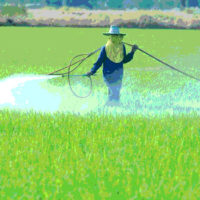With the complexity of our food chain increasing, food safety has become more complicated. Making matters more concerning, the food supply chain crosses many borders, so the challenges, risks and concerns from one part of the world are no longer held within national boundaries. The task of ensuring food safety now demands a completely different mindset, as well as new approaches and more extensive regulations.
However, the regulations, standards and technologies to date have been misaligned and cannot meet the evolving global food safety imperative. For example, small U.S. Department of Agriculture food processors have minimal testing requirements--often only taking as few as five to 10 environmental samples per month in infrequent batches. That means that a potential safety concern could go undetected for a full month, and contaminated products could be in the hands of consumers around the globe.
To secure the global supply chain, the paradigm must change. It is no longer enough to simply go through the motions of environmental and product testing and response. Today’s global food chain requires a consistent, methodical, proactive approach supported by all elements of the supply chain to ensure food safety.
So what does that mean for the industry?
First and foremost, testing should be a proactive, investigative act designed to eradicate pathogens from the environment before products leave the warehouse. In addition, response time should be measured in hours--not days--to limit consumer concern. And last but certainly not least, information should be transparent at all steps along the way. This requires a change in mindset, regulations and tools.
Just Enough Is Not Enough
In a production plant, there are many areas where precision to a given specification is critical. Containers must be filled to the right level or else they will lead to a poor product. Cleaners must be executed at the right concentration--too low will be ineffective and too high can be dangerous to equipment, personnel and the environment. However, environmental testing only to the letter of the current regulations will not keep a plant free of pathogens.
Verification monitoring programs should be the basis of regulatory testing. This testing should measure the effectiveness of preventative controls and/or Hazard Analysis & Critical Control Points program. The test results from these sites should be negative. However, if the environmental program is limited to verification testing, the plant is still at risk.
Relying on verification testing only does not provide a good understanding of the plant – the view is limited and confined. For instance, there is no clear way to determine where Listeria may be introduced to the plant. Cleanup and mitigation efforts will be merely reactive, and therefore ineffective.
In contrast, Land O’ Frost Vice President John Butts, Ph.D., spoke in our webinar about the use of indicator site and not-for-cause investigative testing. This should be the base of a proper testing pyramid. Not-for-cause investigative samples should be taken to:
- Identify new growth niches
- Identify transfer vectors
- Establish new procedures
- Identify indicator sites
This data can be used to truly understand and manage food-processing plants and better secure the global food chain. Yes, there will absolutely be positive samples found, and that is not a bad thing. The difference is that as soon as problematic areas are identified, they can be eradicated. With a different mindset at each stage of the supply chain, we can prevent contamination. However, companies need support to do this.
The External Changes
For companies to take a more aggressive approach to pathogen testing, they need to be supported and encouraged by the regulations and by the certification standards to do so. We also need to level the playing field so that companies with less aggressive approaches have the support and incentives they need to keep up. As a global supply chain, we are measured by the weakest link.
The Food Safety Modernization Act is a critical step in ensuring that all components of the supply chain have the guidance and support needed to keep product safe. However, more specific requirements are needed for product and environmental testing. For instance, environmental testing must support preventive controls. Only with this data will food safety managers be able to gather the critical information needed to quickly react to hazards, and even potential hazards, so they can iterate their program for prevention. This, of course, becomes even more critical based on the nature of the product. However, as an industry, it is important to be vigilant even in lower risk areas. It’s been said that with changing user habits, all product should be treated as ready-to-eat. There is no reason to take on added risk.
Another critical element is certifications, including the latest British Retail Consortium (BRC) standard. This update focuses on consistency of the audit process and flexibility to reduce the audit burden. It also targets better transparency and traceability, while encouraging the use of systems.
Having systems in place is a critical piece of the global food chain safety puzzle. Hopefully, the new focus on it based on BRC will spur change. The amount of food safety data that is generated in a plant today is staggering. For this data to be meaningful and actionable both to the plant and to certifications, it needs to be stored in a database rather than a spreadsheet. It is not enough just to collect data. Histories and queries should also be readily accessible. Trends need to be analyzed. Environmental monitoring software needs to be commonplace in food production plants, and this data needs to be shared across the industry and supply chain. We can learn from each other, and our standards should encourage this visibility and collaboration.
However, while new laws, certifications and audits strive to improve the safety of our food supply, they cannot be successful if they are based on old technology and antiquated systems.
The Proper Toolset
With a proactive mindset and the support of certifications and regulations established as the foundation, the focus shifts to specific tools needed to secure the global supply chain. First and foremost, real-time diagnostics are needed. In order to aggressively and proactively test, food companies need results when the data is still actionable. Testing data is most valuable when the sources can be properly investigated--before multiple cleaning cycles and, most importantly, before the food gets into the hands of consumers.
Food companies not only need tools that can analyze increasing amounts of data and deliver actionable visibility into the relationship between test points and workflows, but also support for the inevitable. There will always be potential contaminations, so the importance of proper remediation plans will never go away. The industry must set clear protocols that are understood and executed consistently across the plant, the organization and the food supply chain at large. When suppliers, customers and regulators work together to share key findings and best practices, an issue found once can be isolated and stopped in its tracks rather than becoming a recurring, industry-wide problem.
By reducing risk across the plant and sharing information across the industry, the global food supply chain becomes safer. It is time to raise the bar and make food safety a proactive priority rather and a reactive crisis. Working together to proactively secure the supply chain, the food industry can eradicate food borne illness and likely save some lives along the way.
Tim Curran is the CEO of Sample6.




